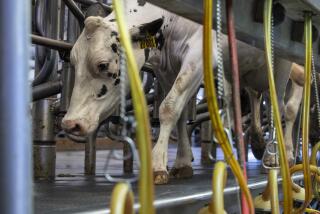Girls’ Success in Livestock Contest Is No Bull
- Share via
VENTURA — Although she’s only a baby, 514-pound Caf’A’Mocha tends to get pushy, and then the calf occasionally engages in bruising toe-stepping matches with her 16-year-old owner, Monique Saulet.
But Monique, this year’s Ventura County Fair grand champion in the replacement heifer category, is prepared for any challenges, wearing her steel-tipped Doc Martens and an attitude that proclaims her the boss.
This year is the first for the replacement heifer category. These animals are raised for breeding, rather than eating.
“Most people don’t picture girls raising heifers or any large animals because they will step on you and push you around,” said Monique, a Santa Rosa student who won last year’s calf competition. “So I just have to show [the heifer] that I’m the boss and that she can’t push me around.”
Monique has been joined this year by an unprecedented number of girls competing and winning in the large livestock competitions. Of the 20 champions and reserve champions in all categories this year, only seven are boys. All eight top winners in the largest animal categories--heifers and steers--are girls.
Some think it’s a sign of the times.
“I started in 1975 and there were very few girls,” said Craig Fosdick, the fair’s large-livestock superintendent. “Back then the girls were encouraged to go into cooking and sewing and that kind of thing. But now there are more opportunities available to them.”
Raising large livestock is not easy. Not only do the owners rise at the crack of dawn to feed the cows, pigs or goats, but they must learn how to manage animals that may outweigh them by half a ton.
“Being girls, they don’t have the strength to handle [the cattle],” Fosdick said. “But they can be taught. It is not so much strength as technique.”
Those skills are tested when the young competitors must exercise the animal and find ways of coaxing it along.
Twelve-year-old Ryanne Fortney of Somis, the youngest winner in the livestock competition, found a clever way to persuade her 1,200-pound steer--named Wildthing--to follow her lead.
*
The name, she said, describes his personality. So Ryanne would stick a carrot in her back pocket when taking Wildthing out on his daily exercise. He would occasionally nibble at the tasty orange vegetable, but because Ryanne always kept a few steps ahead of him, Wildthing would complete his walk.
“Sometimes he would pin me against the wall, but when he saw the food coming he was OK,” said Ryanne, who entered the competition for the first time this year. “This takes a lot of time and effort.”
Ryanne was encouraged and guided by her father, Morry, who said he was so nervous on judging day earlier this week that he felt lightheaded. The animals that weren’t taken home by their owners were auctioned off Friday.
Whether it is raising cattle or playing softball, Morry Fortney said he has always encouraged his daughters to go after what they want.
“I have two girls and I tell them anything they want to pursue in their future they should go out and strive for it,” he said. “They have so many opportunities open to them.”
*
Thirteen-year-old Luana Barajas, who won reserve grand champion for her market goat named Copito de Nieve, agrees.
“It’s good that girls are winning,” said the shy Fillmore resident as her goat chewed on the Kelly green bandanna around her neck. “When some people think of girls, they think they should be in the kitchen instead of raising animals. It’s good that we have these opportunities.”
There are other reasons some participants think the increase in female competitors is good.
The number of girls has “tripled in the last four years,” said Brian Reed, 17, of Santa Paula and a member of Future Farmers of America. “It’s cool. There is more competition and more girls to meet.”
Indeed, it appears that the girls are here to stay.
Already, Ryanne is thinking about next year’s steer competition.
“Everyone’s saying it’s beginners’ luck, but I’m gonna come back next year and show ‘em.”
More to Read
Sign up for Essential California
The most important California stories and recommendations in your inbox every morning.
You may occasionally receive promotional content from the Los Angeles Times.













